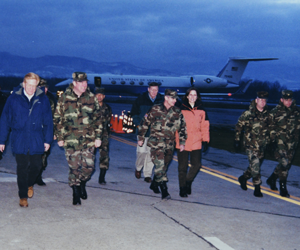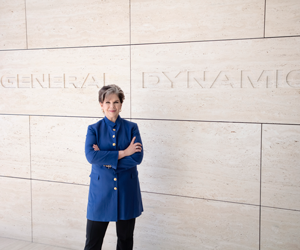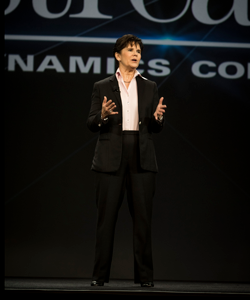War and peace
2020 Virginia Business Person of the Year: Phebe Novakovic leads world’s third-largest defense contractor
War and peace
2020 Virginia Business Person of the Year: Phebe Novakovic leads world’s third-largest defense contractor
Like a lot of bosses in spring and summer 2020, Phebe Novakovic confronted challenges from the COVID-19 pandemic. It threatened lives and economies. Managers weren’t sure when some customers would be able to pay their bills. Employees were anxious; clients were understandably skittish. With travel shutting down, in-person sales demonstrations were curtailed.
But unlike most bosses, Novakovic — pronounced “no-vah-KO-vic” — runs the world’s third-largest defense contractor, Reston-based General Dynamics Corp. A Fortune 100 manufacturer of business jets, warships, submarines, tanks and communications systems, it employs more than 100,000 workers worldwide. Simply shutting down General Dynamics’ operations was not an option: The U.S. government, the company’s largest customer, designated General Dynamics’ defense and aerospace manufacturing operations as critical infrastructure
So Novakovic did what colleagues say she always does: She talked to leaders of business units, managers, board members and trusted medical advisers. She learned. And she laid out a clear series of steps to get through the crisis, trusting her division heads to do their jobs.
Among the actions implemented, Novakovic decided to pay more than $1 billion in cash advances to General Dynamics suppliers in order to ensure that the company’s supply chain remained strong and wasn’t disrupted by the pandemic.
Additionally, General Dynamics conducted a companywide inventory for personal protective gear, ensuring proper protective wear reached the appropriate divisions and employees, as well as making surplus goods such as latex gloves available to the federal government and agencies such as the New York Police Department.
“Like any crisis, COVID is like an audit of your organization,” says former Secretary of Defense Jim Mattis, the retired U.S. Marine Corps general who served on General Dynamics’ board from 2013 to 2017 and rejoined in 2019 after leaving the Trump administration. “Do you have the shock absorbers in place? Have you spent enough time teaching your young folks how to lead when a shock like this is hitting the economy?”
Novakovic demonstrated exactly that, Mattis says. “Just the idea of setting the standards — what would close, what was kept open — shows you someone who is integrating just a mass of detail,” he adds. “Any crisis is a race between time and knowledge. She could not delay decisions until all the information was available, because in a crisis all the information is never available. And she was able to make the right calls and do it when people were literally dying.”
This year, in the midst of a worldwide catastrophe, when other companies were posting significant losses, General Dynamics posted second-quarter and third-quarter revenues of $9.3 billion and $9.4 billion — not too much below the $9.6 billion and $9.8 billion it posted for the same periods in 2019.

Last year, General Dynamics won the largest Navy contract ever awarded, a $22.2 billion multiyear order to build nine nuclear-powered, fast-attack Virginia-class submarines, with a $2 billion option to build a 10th submarine. And this October, the company’s information technology division landed a $4.4 billion IT contract from the Department of Defense. A week later, in early November, General Dynamics received a $9.4 billion contract modification to build and test the Navy’s first two Columbia-class intercontinental ballistic missile submarines.
Results like those are why Virginia Business has named Novakovic its 2020 Business Person of the Year. The blunt-talking CEO has steered the defense, manufacturing, business aviation and IT services behemoth to consistent profit since 2013. And she’s done it through a straightforward philosophy: Be honest. Be direct. And know what you’re talking about.
Power player
Considering she is often ranked one of the world’s most powerful women (Forbes ranks her as more powerful than Queen Elizabeth II), Novakovic keeps a remarkably low profile. Other than quarterly earnings calls and occasional appearances at business conferences, Novakovic avoids the spotlight and rarely gives interviews to the press
.
That suits her role; defense companies work mostly with government agencies rather than the public. It also suits her personal preferences.
She agreed to speak to Virginia Business, she says, as a way to honor the roughly 10,900 General Dynamics employees in Virginia. “Particularly this year, I think it’s important sometimes to be a little more public, to thank all the people who make this company what it is.”
In conversation, Novakovic, a 62-year-old mother of three grown children and grandmother of three, is direct and no-nonsense, with a wide and precisely deployed vocabulary.
Novakovic’s father emigrated from Serbia to the United States at age 17 after World War II. He met her mother, who had grown up in the U.S., at Syracuse University. After they married, he joined the U.S. Air Force’s intelligence service.
As a child growing up in Europe during the Cold War, Novakovic saw the dangers confronting the United States and felt the pride of being a U.S. citizen. She calls herself a fierce, unapologetic patriot. The family returned to the U.S. when she was a teen.
She graduated from Smith College as a liberal arts major. At the prestigious New England private women’s college (alumnae range from Sylvia Plath and Gloria Steinem to Nancy Reagan and Barbara Bush), Novakovic studied history and learned to love literature. She’s read “War and Peace” a dozen times.
At Smith, she says, she learned to think and to understand human nature — assets in the defense industry. “A leader who fails to think is a leader who fails to lead,” Novakovic adds. “The ability to take complex facts and mold them into a coherent set of information to make judgments and our best guesses on the way forward — that is an important skill.”
After earning her bachelor’s degree, Novakovic worked for a small military contractor and in 1983 joined the CIA. Like most former “spooks,” she doesn’t discuss her spy years, saying only that her career as a CIA operative was “an effort to serve my nation as best I could.”
During her time in the CIA, she met her first husband, Michael Vickers, an ex-Green Beret who helped run a program to arm Afghan mujahedeen in their war to drive out the Soviet Union. Vickers and Novakovic married in 1985; a year later the couple enrolled at the Wharton School of the University of Pennsylvania, where both earned MBAs.
Novakovic’s Wharton degree proved no guarantee for success. She mailed out 50 résumés and didn’t receive a single job offer. One manager said she was overqualified; another said she lacked relevant experience. In 1992 Novakovic landed a job at the federal Office of Management and Budget, quickly rising to deputy associate director for national security. She was responsible for overseeing and submitting the president’s budget for defense and intelligence agencies.
“It was a superb place to learn at the highest level the processes of government [and] the interstices of the defense budget,” she recalls.
Five years later, Novakovic went to work at the Pentagon as a top assistant to deputy defense secretaries John Hamre and Rudy de Leon. When she decided to move to the private sector, she took a close look at the top defense companies. She chose General Dynamics partly because its CEO, Serbian-American lawyer Nicholas Chabraja, had been a successful Chicago trial attorney rather than starting as a company program manager.
“Because I have a bit of an iconoclastic background myself, I thought maybe there would be a place for me” at General Dynamics, she says. “And my intuition was correct.” She joined the company in 2001 as vice president for strategic planning.
Steady ascent
General Dynamics traces its founding to 1899, developing submarines for the U.S. Navy. After World War II, a series of mergers added aircraft manufacturing to its offerings, leading to the company’s current name. By the 1980s, General Dynamics was building F-16 fighter jets, Cessna aircraft and Abrams tanks. In the early to mid-1990s, when the defense industry contracted at the end of the Cold War, the company sold off divisions, including aircraft, space and data systems. But under Chabraja, General Dynamics began to rebuild in the late 1990s, expanding in Europe and buying high-end jet company Gulfstream Aerospace Corp.
Chabraja became a mentor to Novakovic and gave her increasingly prominent jobs. In 2005, she was promoted to senior vice president.

When Chabraja retired in 2009, however, the CEO job went to a board member and former chief of Navy operations, Jay Johnson. Novakovic was promoted to executive vice president for the company’s marine systems group, which designs, builds and repairs ships and submarines and has shipyards in Norfolk; Groton, Connecticut; San Diego; and Bath, Maine.
While Novakovic led acquisitions that expanded the ship-repair business, Johnson’s leadership of General Dynamics was hitting choppy waters. A post-Iraq War drawdown shrank the defense budget. Meanwhile, Johnson bet big on information technology, paying almost $1 billion for a health care IT provider and millions more on smaller businesses.
In May 2012, Novakovic became General Dynamics’ president and chief operating officer. A month later, the company announced Johnson would be stepping down by the end of 2012 and named Novakovic as his replacement. In January 2013, weeks after Novakovic took over as CEO, the company reported that sales in its information systems business had fallen $1.2 billion in the previous year and, shockingly, that General Dynamics was taking a $2 billion writedown on a series of acquisitions in information systems and technology. It marked the first time in decades the company had posted an annual loss — $332 million.
Guiding philosophy
As CEO, one of Novakovic’s first moves was to establish a set of simple, consistent corporate rules. She called them an ethos because “ethos is a more profound word than ethics — it means your fundamental moral character.”
She explained the principles to her team: honesty, transparency, trust and alignment, the last of which Novakovic calls “code for teamwork.” And those who didn’t follow the ethos? “I fired them.”
Novakovic makes it clear she does not think much of employees who are dishonest or try to hide problems.
“The only way to get instantaneously fired, at least in my realm, is to lie,” she explains, “because you have destroyed the fundamental thread which binds our moral code together.”
Novakovic spent her first five years as CEO managing costs and rebuilding the culture. “She fundamentally made sure the place was running right operationally,” says Wesley G. Bush, chairman and former CEO of Northrop Grumman Corp., the Falls Church-based Fortune 100 aerospace and defense contractor. “It’s easy in a CEO role to get caught up in transactional activities, chasing the next big thing. [Instead], she focused on operations.”
General Dynamics’ units operate largely independently, with little duplication of roles between its far-flung divisions and its low-key headquarters campus in Reston, where the company relocated in September 2019 from its previous headquarters in a Falls Church high-rise.
Leaders are given wide latitude to make decisions and move quickly without prior approval.
Mattis compares Novakovic’s approach to George Washington’s openness to good ideas. “Phebe would listen with a willingness to be persuaded, if it’s a strongly reasoned position,” the general says. “She would listen and help sharpen the discussion. … And then she would lead.”
In return, General Dynamics unit leaders are expected to report regularly to headquarters using a consistent format, and to immediately signal if they detect problems. “When we make a mistake, we tell each other … so we can work to fix it,” Novakovic says.
Novakovic keeps a laser focus on cash over flashy projects or ones that boost revenue without increasing profit, says Jim Crown, a third-generation General Dynamics board member and lead director.
Access to cash offers stability and flexibility, Novakovic notes: “At the end of the day, if you’re a very large corporation or a very small business, cash is what perpetuates the enterprise.” Cash also lets the company reward shareholders through dividends and stock repurchases. Since 2007, General Dynamics has bought back more than $17 billion in stock, including $1.33 billion in 2018.
Board members praise Novakovic’s focused, finance- and data-driven approach. Opportunities that don’t prove themselves are passed by.
Recently General Dynamics has started moving into new territory. In 2018, Novakovic led the company’s largest acquisition to date, $9.7 billion for Falls Church-based government IT services conglomerate CSRA Inc., which vaulted General Dynamics into a market leader in that sector. The acquisition paid off this year, when the General Services Administration announced in October that General Dynamics Information Technology Inc. would be awarded the $4.4 billion, 10-year Defense Enterprise Office Solutions (DEOS) contract that had previously belonged to CSRA.

Like opportunities, challenges are everywhere. Cybersecurity is a major issue. Novakovic said last year that her company fights off 13 billion cyber break-in attempts every month. Meanwhile, shifting presidential priorities and budgets can rattle the business landscape: The U.S. government provides approximately two-thirds of General Dynamics’ income. The company spends more than $10 million a year on lobbying, according to Open Secrets.
Overseas sales, even to allies, also can be complicated. In 2018, the Canadian government and Saudi Arabia got into a diplomatic dispute over human rights. At the time, a Canadian division of General Dynamics was working on a $13 billion contract with the Canadian government to supply light armored vehicles to the Saudis. The Saudis froze their payments to Canada for the vehicles, causing General Dynamics to miss out on $1.5 billion in 2019 revenue. Novakovic held firm with Canada, pointing out that scrapping the contract would force Canada to pay $750 million in penalties and purchase any vehicles that had been built. In April 2020, Canada announced it had settled the dispute, allowing the payments from the Saudis to flow once again. Canadian Prime Minister Justin Trudeau acknowledged that his nation’s contractual obligations with General Dynamics were a major factor.
More recently, in June, 4,300 unionized employees at General Dynamics’ Bath Iron Works shipyard in Maine went on strike over issues including seniority, benefits and the use of subcontractor labor, delaying work on seven Navy destroyers. After seven weeks, the strike ended on mutually agreeable terms via federal mediation.
Through it all, for the third quarter of this pandemic year General Dynamics reported earnings of $834 million on $9.43 billion in revenue, just 3.4% less than third quarter revenues in 2019. And the resulting diluted earnings of $2.90 per share beat analysts’ predictions.
As Mattis says of Novakovic: “She’s a leader. And I’m still learning from her.”
Phebe N. Novakovic
Title: Chairman and CEO
Age: 62
Family: Husband, David Morrison (former lobbyist for The Boeing Co.); three children, three grandchildren
Education: Bachelor’s degree, Smith College; MBA, Wharton School of the University of Pennsylvania
2019 pay: $18.3 million ($1.6 million salary plus stock and options)
Board memberships: JPMorgan Chase & Co., Abbott Laboratories, Northwestern University, Congressional Medal of Honor Foundation, National Military Family Association, Association of the United States Army, Ford’s Theatre



















